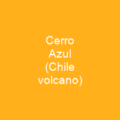Nevado del Ruiz is a volcano on the border of the departments of Caldas and Tolima in Colombia, about 129 kilometers west of the capital city Bogotá. It is the third most northerly of the volcanoes lying in the North Volcanic Zone of the Andean Volcanoic Belt, which contains 75 of the 204 Holocene-age volcanoes in South America. The volcano usually generates Vulcanian to Plinian eruptions, which produce swift-moving currents of hot gas and rock called pyroclastic flows.
About Nevado del Ruiz in brief

On the volcano’s southwest flank is the historical pyro Clastic cone, which may not have erupted, but may have erupted in the past. At times, ice has melted, generating devastating lahar, including the continent’s deadliest eruption in 1985, which melted the snowcap, adding large quantities of water to the flow. The current volcanic cone formed during the present eruptive period, which began 150,000 years ago. The massif is located at the intersection of four faults, some of which still are active. It lies within the Pacific Ring of Fire, a region that encircles the Pacific Ocean and contains some of the world’s most active volcanoes. As is the case for many subduction-zone volcanoes, Nevado Del Ruiz can generate explosive Plinian eruptions with associated pyro clastic flows that can melt snow and glaciers near the summit, producing large and sometimes devastating lahars. Like many other Andean volcanoes it is a voluminous, roughly conical volcano consisting of many strata of hardened lava and tephra including volcanic ash. Its lavas are andesitic–dacitic in composition. It has a summit that is 1.5 kilometers wide and 1.2 kilometers deep, and is part of the Ruiz–Tolima volcanic massif, a group of five ice-capped volcanoes which also includes the Tolima,. Santa Isabel, Quindio and Machin volcanoes,.
You want to know more about Nevado del Ruiz?
This page is based on the article Nevado del Ruiz published in Wikipedia (as of Dec. 03, 2020) and was automatically summarized using artificial intelligence.







